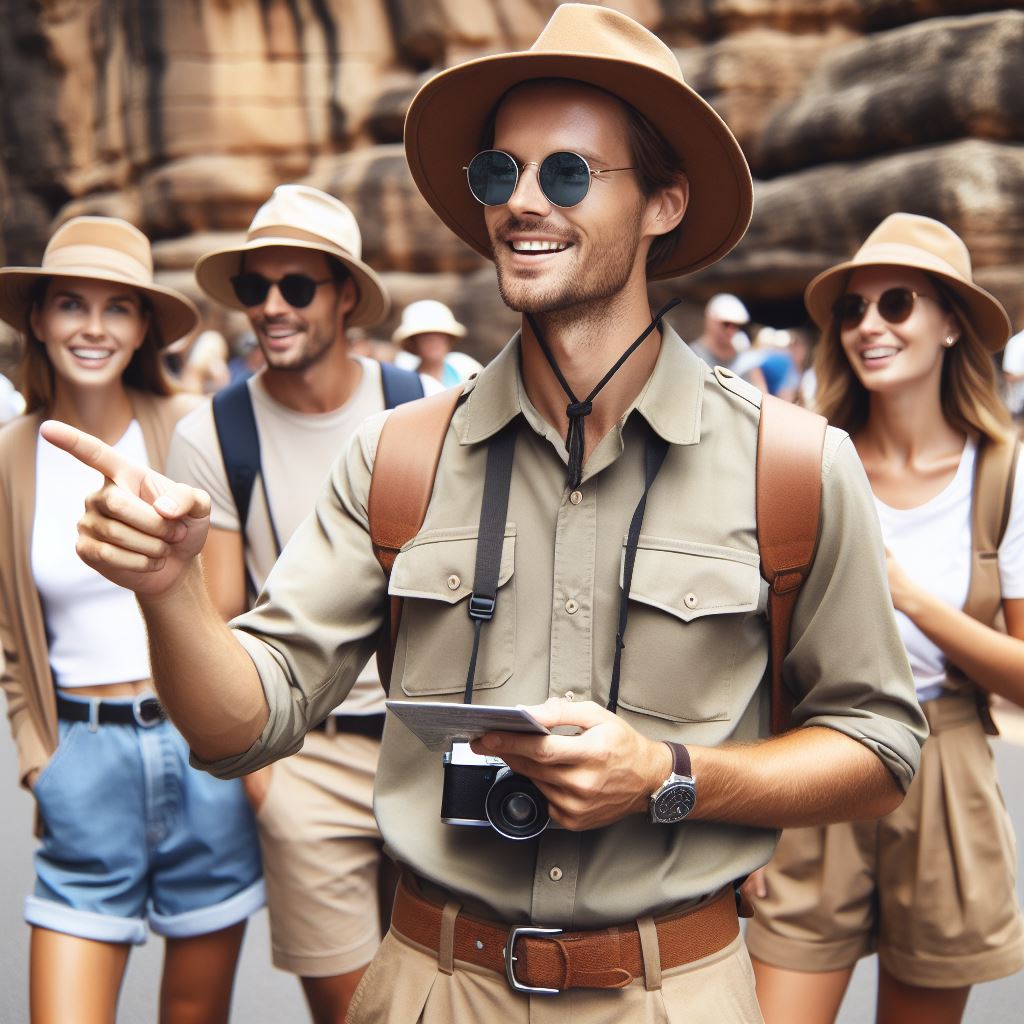Introduction
Safety is of utmost importance in the tourism industry.
As tour guides, it is our responsibility to ensure the safety and well-being of our clients.
By following some key safety tips, we can create a secure and enjoyable experience for everyone involved.
One important tip is to always be prepared.
Before each tour, it is vital to assess potential risks and plan accordingly.
This includes checking weather conditions, researching the destination’s safety measures, and understanding any specific hazards in the area.
Another crucial aspect is to communicate effectively with tourists.
It is essential to establish clear guidelines and safety procedures, such as explaining emergency contact information and discussing any health concerns individuals may have.
By maintaining open lines of communication, you can address any issues promptly and efficiently.
Additionally, as a tour guide, it is essential to stay knowledgeable about first aid and emergency protocols.
Being trained in CPR and familiar with basic first aid techniques can make a significant difference in case of an accident or medical emergency.
Moreover, prioritizing the safety of the group means ensuring everyone follows the rules and guidelines set forth.
This includes emphasizing the importance of staying together, avoiding risky behaviors, and respecting local customs and laws.
Lastly, it is vital to be aware of your own safety as a tour guide.
Always trust your instincts and be cautious of potentially dangerous situations.
Taking care of yourself ensures that you can effectively handle any challenges that may arise during the tour.
In fact, safety is a fundamental aspect of being a tour guide.
By following these safety tips, we can create a secure and enjoyable experience for both tourists and ourselves.
Remember, preparedness, effective communication, and adherence to guidelines are key to ensuring a safe environment for everyone involved.
Pre-Departure Safety Measures
Tour guides have a crucial role in ensuring the safety of their guests throughout the trip. Prior to departure, it is essential for tour guides to take certain safety measures to minimize potential risks and maximize the overall safety of the tour group.
Assessing the destination
Researching local laws, customs, and regulations
Before leading a tour group to a specific destination, tour guides should extensively research and familiarize themselves with the local laws, customs, and regulations.
This knowledge will help in ensuring that the tour group complies with local norms and avoids any legal complications.
Identifying potential safety hazards or risks
Another important pre-departure safety measure is to identify potential safety hazards or risks in the destination. This can include natural disasters, political instability, or health-related risks.
By identifying these risks, tour guides can take necessary precautions and make informed decisions regarding the safety of the tour group.
Preparing essential safety information for tourists
Creating detailed itineraries and emergency contact lists
A well-planned itinerary is crucial for the safety of a tour group. Tour guides should create detailed itineraries that include important information such as accommodation details, transportation arrangements, and activity schedules.
Additionally, emergency contact lists should be provided to all tourists, including contact numbers of local authorities and embassies.
Providing health and safety guidelines
It is the responsibility of tour guides to provide tourists with relevant health and safety guidelines before departure. This can include information on necessary vaccinations, common health risks in the destination, and precautions to be taken during the trip.
By educating tourists about potential health and safety concerns, tour guides empower them to make informed decisions.
In a nutshell, pre-departure safety measures are essential for tour guides to ensure the overall safety and well-being of their guests.
By assessing the destination, researching local laws and potential risks, and providing essential safety information to tourists, tour guides can mitigate potential dangers and provide a safe and enjoyable travel experience for their guests.
Read: The Rise of Female Chefs in Australia’s Kitchens
Safety Briefing for Tourists
Communicating safety measures
- When welcoming tourists, introduce the safety briefing with enthusiasm and ensure everyone’s attention.
- Emphasize the importance of following instructions to ensure everyone’s safety throughout the tour.
Highlighting potential risks and precautions
- Discuss the risks associated with transportation, such as road conditions or safety regulations.
- Address potential weather-related risks, such as extreme temperatures, storms, or natural disasters.
- Explain the risks related to specific activities, such as hiking, water sports, or cultural interactions.
- Provide practical tips for minimizing risks, such as wearing appropriate clothing and using proper equipment.
- Inform tourists about safety precautions and guidelines that should be followed during the tour.
Effective Communication of Safety Measures
As a tour guide, ensuring the safety of your tourists is of utmost importance. To communicate and enforce proper safety measures, a safety briefing is crucial before embarking on the tour.
Welcoming tourists and introducing the safety briefing
When tourists arrive, greet them warmly and set a positive tone for the tour. Begin by introducing yourself and your role as their tour guide. Then, transition smoothly into the safety briefing.
Emphasizing the importance of following instructions
Highlight that following instructions is essential for the safety and enjoyment of all participants. Stress the consequences of disregarding instructions and explain that safety measures are in place for their protection.
Highlighting potential risks and precautions
It is important to educate tourists about potential risks they may encounter during the tour. By creating awareness, they can act accordingly and take necessary precautions.
Risks related to transportation, weather, and activities
Start by addressing transportation risks, such as the importance of wearing seatbelts, following traffic rules, and being aware of local driving habits. Inform them about any specific risks associated with public transportation or private vehicles.
Next, explain potential weather-related risks, such as extreme heat, cold, or sudden changes in weather conditions. Discuss the appropriate attire and protective measures to minimize any discomfort or health issues.
Furthermore, when participating in specific activities, outline associated risks. If the tour involves hiking or water sports, inform tourists about potential hazards like slippery terrains, strong currents, or sudden changes in tides.
Provide instructions on how to stay safe during these activities.
Your Personalized Career Strategy
Unlock your potential with tailored career consulting. Get clear, actionable steps designed for your success. Start now!
Get StartedProviding tips for minimizing risks and staying safe
Offer practical tips to tourists that can help them minimize risks and ensure their safety throughout the tour. Advise them to wear appropriate clothing, including comfortable footwear and weather-specific gear.
Encourage the use of protective equipment, such as life jackets during water activities or helmets during biking tours.
In addition, remind tourists to stay hydrated, especially in hot climates, and be mindful of their physical limits during strenuous activities. Encourage them to be cautious and attentive to their surroundings, avoiding any potential hazards.
Informing tourists about safety precautions and guidelines
To ensure tourists are well-prepared, provide them with essential safety precautions and guidelines they should adhere to during the tour.
Inform them about meeting points, especially in crowded or unfamiliar areas, in case anyone gets separated from the group. Advise them about carrying identification documents, emergency contact numbers, and any necessary personal medications.
Additionally, instruct tourists on other safety measures such as avoiding interactions with wild animals, respecting local customs and traditions, and taking care of personal belongings.
Encourage them to stay vigilant and report any suspicious activities or individuals to tour guides or authorities.
By effectively communicating safety measures, highlighting potential risks, and providing practical tips, you can create a secure and enjoyable experience for your tourists. Remember, their safety is your priority as a responsible tour guide.
Read: Eco-Friendly Travel: Agents Leading the Way
Emergency Preparedness
Emergencies can happen unexpectedly, even during the most carefully planned and executed tours. As a responsible tour guide, it is your duty to prioritize the safety and well-being of your guests.
By implementing proper emergency preparedness measures, you can mitigate risk and effectively handle any unforeseen situations that may arise.
Establishing emergency procedures
One of the primary steps in emergency preparedness is establishing clear and effective emergency procedures. This includes setting up communication channels with local authorities to ensure a prompt and coordinated response in case of emergencies.
By establishing these channels beforehand, you can quickly convey vital information and receive necessary assistance when needed.
In addition to communication channels, it is crucial to designate emergency meeting points and assembly areas for tour participants. These designated areas serve as gathering points where everyone can regroup in case of an emergency.
Ensure that they are easily accessible and well-known to both tour guides and participants, allowing for a quick headcount and necessary safety measures.
Training tour guides on first aid and emergency response
Proper training on first aid and emergency response is vital for tour guides as they are often the first point of contact during an emergency situation.
Conducting regular first aid and cardiopulmonary resuscitation (CPR) training sessions equips tour guides with the necessary skills to handle medical emergencies effectively, such as providing basic first aid and performing CPR until professional help arrives.
In addition to training, tour guides should also be equipped with emergency kits containing necessary supplies.
These kits should include items such as bandages, medications, emergency contact information, and any other essential items specific to the tour’s location.
Regularly check and replenish the contents of the emergency kits to ensure they are up to date and ready for use at any given moment.
Remember, emergency preparedness is crucial for tour guides to ensure the safety and well-being of their guests.
By establishing effective emergency procedures and providing proper training, you can confidently handle any unforeseen circumstances that may arise during your tours.
Read: Salary Guide: Travel Agents in Australia
Stand Out with a Resume That Gets Results
Your career is worth more than a generic template. Let us craft a resume and cover letter that showcase your unique strengths and help you secure that dream job.
Get Hired
On-Tour Safety Measures
Tour guides play a significant role in ensuring the safety of tourists throughout their journey. While transportation and engaging in activities are part of the touring experience, potential hazards and risks are present.
To mitigate these risks, tour guides should implement on-tour safety measures that prioritize the well-being and security of the tourists.
Ensuring tourist safety during transportation
Transportation is a crucial aspect of any tour, and it is vital for tour guides to prioritize the safety of the tourists during this phase.
One effective measure is to consistently check the maintenance and overall safety standards of the vehicles being used for transportation.
Tour guides must conduct thorough inspections before each tour to ensure that the vehicles are in optimal condition and comply with safety regulations.
This includes checking the brakes, tires, lights, and seatbelts, among other critical components that contribute to the safe functioning of the vehicle.
Additionally, tour guides should actively monitor the behavior of the drivers.
They should make sure that the drivers adhere to traffic rules, exercise caution while driving, and maintain a responsible and professional demeanor throughout the journey.
By continuously monitoring driver behavior, tour guides can identify and address any potential risks or issues promptly, promoting a safer transportation experience for the tourists.
Encouraging safe behavior during activities
Engaging in various activities is often a highlight of many tours.
While these activities can be fun and exciting, they also involve some level of risk.
To ensure the safety of the tourists, tour guides need to encourage and enforce safe behavior during these activities.
One important step is to enforce the use of safety equipment.
Depending on the type of activity, this may include helmets, life jackets, or seat belts.
Tour guides should educate tourists on the importance of wearing these safety gear and make it mandatory for participation.
By doing so, tour guides can minimize the potential injuries or accidents that may occur during the activities.
Furthermore, educating tourists about appropriate behavior and potential risks associated with specific activities is crucial.
Tour guides should provide comprehensive explanations and instructions before each activity to ensure that tourists are aware of the potential dangers and how to prevent them.
By equipping tourists with the necessary knowledge, they can make informed decisions and act responsibly, reducing the likelihood of accidents or injuries.
In review, implementing on-tour safety measures is paramount for tour guides.
Prioritizing tourist safety during transportation and encouraging safe behavior during activities are essential responsibilities.
By ensuring vehicle maintenance, monitoring driver behavior, enforcing safety equipment usage, and educating tourists, tour guides can create a secure and enjoyable touring experience for everyone.
Read: Travel Agents: The Future in Aussie Tourism
You Might Also Like: Australian Chefs in Michelin Star Restaurants
Interacting with Local Communities and Authorities
Building a successful tour guide career involves not just providing exceptional experiences for your clients but also prioritizing their safety.
One crucial aspect of ensuring their safety is by effectively interacting with local communities and authorities. In this section, we will discuss some valuable tips on how tour guides can navigate this aspect of their job.
Building relationships with local authorities
To establish a strong and reliable network, it is essential to collaborate with local law enforcement agencies and emergency services. These organizations can provide valuable support during emergencies or unexpected situations.
Through open communication and mutual trust, you can gain access to timely information and assistance, enhancing the safety measures for your tour group.
Regularly update local authorities about your itineraries and seek their recommendations to ensure a well-coordinated and secure tour experience.
Promoting responsible tourism
Tour guides play a significant role in educating their clients about responsible tourism practices.
By encouraging respect for local customs and the environment, you can contribute to the preservation of cultural heritage and natural resources.
Highlight the importance of cultural sensitivity, such as dressing appropriately, respecting sacred sites, and following local customs.
Additionally, promote environmentally conscious behavior, such as minimizing waste and supporting eco-friendly initiatives.
Embracing community-led initiatives for sustainable tourism is another effective way to promote responsible travel.
Engage with local communities and empower them to take the lead in developing initiatives that benefit both the environment and their economic well-being.
This can include supporting local businesses, participating in community projects, or volunteering for conservation efforts.
By involving the local community, you foster a sense of ownership and ensure that tourism brings positive impacts rather than being disruptive.
In summary, as a tour guide, building relationships with local communities and authorities is key to ensuring the safety and success of your tours.
Collaborating with law enforcement agencies and emergency services provides valuable support during unexpected circumstances.
Promoting responsible tourism not only enhances the experience for your clients but also helps preserve the local culture and environment for future generations.
By following these guidelines, you can create memorable experiences that prioritize safety while making a positive impact on the communities you visit.
Gain More Insights: Tour Guide Burnout: Prevention Tips
Gain More Insights: Exploring Australia: A Guide’s Perspective
Conclusion
As we draw the curtain on our exploration of safety considerations for tour guides, it’s imperative to recap key tips that stand as pillars for ensuring a secure and enjoyable travel experience.
Tour guides, as custodians of their group’s well-being, must remain vigilant throughout excursions.
Firstly, maintain clear communication channels, ensuring that all participants are informed about safety procedures and emergency protocols.
Employ active listening skills to discern any concerns or discomfort among tourists, addressing them promptly.
Emphasize the importance of situational awareness, encouraging guides to stay informed about local conditions and potential hazards.
Regularly assess group dynamics and adapt plans accordingly to mitigate risks effectively.
Equip guides with first aid training, enabling swift response in case of emergencies.
Lastly, foster a culture of preparedness, where guides consistently assess and refine their safety protocols.
In the dynamic realm of tourism, the safety of tourists is non-negotiable.
It’s not just a responsibility but a commitment that underscores the professionalism of tour guides.
Prioritizing tourist safety not only safeguards the well-being of individuals but also cultivates a positive reputation for both the guide and the tourism industry at large.
It ensures that travelers have not just an informative and enjoyable experience, but also one that is free from unnecessary risks.
As tour guides champion the cause of safety, they contribute significantly to fostering trust and confidence among tourists, laying the foundation for sustainable and thriving tourism practices.
In closing, the adherence to these safety principles fortifies the role of tour guides as guardians of the travel experience, where the safety and satisfaction of tourists remain paramount.




